Multi-Source Dataset Assessment and Variation Characteristics of Snow Depth in Eurasia from 1980 to 2018
Abstract
1. Introduction
2. Data and Methods
2.1. Overview of the Study Area
2.2. Data
2.3. Methods
3. Results and Analysis
3.1. Multi-Source Snow Dataset Assessment
3.2. Temporal and Spatial Variation Characteristics of Snow in Eurasia
4. Discussion and Conclusions
4.1. Discussion
4.2. Conclusions
Author Contributions
Funding
Institutional Review Board Statement
Informed Consent Statement
Data Availability Statement
Conflicts of Interest
References
- Barnett, T.P.; Dümenil, L.; Schlese, U.; Roeckner, E.; Latif, M. The Effect of Eurasian Snow Cover on Regional and Global Climate Variations. J. Atmos. Sci. 1989, 46, 661–686. [Google Scholar]
- Douville, H.; Royer, J.F. Sensitivity of the Asian summer monsoon to an anomalous Eurasian snow cover within the Météo-France GCM. Clim. Dyn. 1996, 12, 449–466. [Google Scholar] [CrossRef]
- Walland, D.J.; Simmonds, I. Modelled atmospheric response to changes in Northern Hemisphere snow cover. Clim. Dyn. 1996, 13, 25–34. [Google Scholar] [CrossRef]
- Blanford, H.F., II. On the connexion of the Himalayas snowfall with dry winds and seasons of drought in India. Proc. R. Soc. Lond. 1997, 37, 3–22. [Google Scholar] [CrossRef]
- Chen, H.; Xu, B. Spatial and Temporal Features of Snow Depth in Winter over Eurasian Continent and Its Impacting Factors. Geogr. Sci. 2012, 32, 129–135. [Google Scholar]
- Wei, Z.; Dong, W. Assessment of Simulations of Snow Depth in the Qinghai-Tibetan Plateau Using CMIP5 Multi-Models. Arctic, Antarct. Alp. Res. 2015, 47, 611–625. [Google Scholar] [CrossRef][Green Version]
- Zhang, R.; Zhang, R.; Zuo, Z. Characteristics of Winter Snow in China and the Impact of Eurasian Snow on China’s climate. J. Appl. Meteorol. Sci. 2016, 27, 513–526. [Google Scholar]
- Zou, Y.; Wang, Y.; Zhang, Y.; Koo, J. Arctic sea ice, Eurasia snow, and extreme winter haze in China. Sci. Adv. 2017, 3, e1602751. [Google Scholar] [CrossRef] [PubMed]
- Liu, H.; Liu, X.; Dong, B. Influence of Central Siberian Snow-Albedo Feedback on the Spring East Asian Dust Cycle and Connection With the Preceding Winter Arctic Oscillation. J. Geophys. Res. Atmos. 2018, 123, 13368–13385. [Google Scholar] [CrossRef]
- Diffenbaugh, N.S.; Pal, J.S.; Trapp, R.J.; Giorgi, F. Fine-scale processes regulate the response of extreme events to global climate change. Proc. Natl. Acad. Sci. USA 2005, 102, 15774–15778. [Google Scholar] [CrossRef]
- Westerling, A.L. Increasing western US forest wildfire activity: Sensitivity to changes in the timing of spring. Philos. Trans. R. Soc. B Biol. Sci. 2016, 371, 20150178. [Google Scholar] [CrossRef] [PubMed]
- Phan, D.T.; Nguyen, C.H.; Nguyen TD, P.; Tran, L.H.; Park, S.; Choi, J.; Lee, B.; Oh, J. A Flexible, Wearable, and Wireless Biosensor Patch with Internet of Medical Things Applications. Biosensors 2022, 12, 139. [Google Scholar] [CrossRef]
- Phan, D.T.; Ta, Q.B.; Huynh, T.C.; Vo, T.H.; Nguyen, C.H.; Park, S.; Choi, J.; Oh, J. A smart LED therapy device with an automatic facial acne vulgaris diagnosis based on deep learning and internet of things application. Comput. Biol. Med. 2021, 136, 104610. [Google Scholar] [CrossRef]
- Phan, D.T.; Ta, Q.B.; Ly, C.D.; Nguyen, C.H.; Park, S.; Choi, J.; Se, H.O.; Oh, J. Smart Low Level Laser Therapy System for Automatic Facial Dermatological Disorder Diagnosis. IEEE J. Biomed. Health Inform. 2023, 27, 1546–1557. [Google Scholar] [CrossRef]
- Phan, D.T.; Yap, K.H.; Garg, K.; Han, B.S. Vision-Based Early Fire and Smoke Detection for Smart Factory Applications Using FFS-YOLO. In Proceedings of the 2023 IEEE 25th International Workshop on Multimedia Signal Processing (MMSP), Poitiers, France, 27–29 September 2023. [Google Scholar] [CrossRef]
- Barnett, T.P.; Adam, J.C.; Lettenmaier, D.P. Potential impacts of a warming climate on water availability in snow-dominated regions. Nature 2005, 438, 303–309. [Google Scholar] [CrossRef] [PubMed]
- Ruosteenoja, K.; Markkanen, T.; Venäläinen, A.; Räisänen, P.; Peltola, H. Seasonal soil moisture and drought occurrence in Europe in CMIP5 projections for the 21st century. Clim. Dyn. 2018, 50, 1177–1192. [Google Scholar] [CrossRef]
- Damm, A.; Greuell, W.; Landgren, O.; Prettenthaler, F. Impacts of +2 °C global warming on winter tourism demand in Europe. Clim. Serv. 2017, 7, 31–46. [Google Scholar] [CrossRef]
- Steiger, R.; Scott, D.; Abegg, B.; Pons, M.; Aall, C. A critical review of climate change risk for ski tourism. Curr. Issues Tour. 2019, 22, 1343–1379. [Google Scholar] [CrossRef]
- Chen, X.; Liang, S.; Cao, Y.; He, T.; Wang, D. Observed contrast changes in snow cover phenology in northern middle and high latitudes from 2001–2014. Sci. Rep. 2015, 5, 16820. [Google Scholar] [CrossRef]
- Mudryk, L.R.; Kushner, P.J.; Derksen, C. Interpreting observed northern hemisphere snow trends with large ensembles of climate simulations. Clim. Dyn. 2014, 43, 345–359. [Google Scholar] [CrossRef]
- Kunkel, K.E.; Robinson, D.A.; Champion, S.; Yin, X.; Estilow, T.; Frankson, R.M. Trends and Extremes in Northern Hemisphere Snow Characteristics. Curr. Clim. Chang. Rep. 2016, 2, 65–73. [Google Scholar] [CrossRef]
- Groisman, P.Y.; Karl, T.R.; Knight, R.W.; Stenchikov, G.L. Changes in Snow Cover, Temperature, and Radiative Heat Balance over the Northern Hemisphere. J. Clim. 1994, 7, 1633–1656. [Google Scholar]
- Fontrodona Bach, A.; van der Schrier, G.; Melsen, L.A.; Klein Tank, A.M.G.; Teuling, A.J. Widespread and Accelerated Decrease of Observed Mean and Extreme Snow Depth over Europe. Geophys. Res. Lett. 2018, 45, 12312–12319. [Google Scholar] [CrossRef]
- Brown, R.D.; Mote, P.W. The Response of Northern Hemisphere Snow Cover to a Changing Climate. J. Clim. 2009, 22, 2124–2145. [Google Scholar] [CrossRef]
- Beniston, M.; Farinotti, D.; Stoffel, M.; Andreassen, L.M.; Coppola, E.; Eckert, N.; Fantini, A.; Giacona, F.; Hauck, C.; Huss, M.; et al. The European mountain cryosphere: A review of its current state, trends, and future challenges. Cryosphere 2018, 12, 759–794. [Google Scholar] [CrossRef]
- Thackeray, C.W.; Derksen, C.; Fletcher, C.G.; Hall, A. Snow and Climate: Feedbacks, Drivers, and Indices of Change. Curr. Clim. Chang. Rep. 2019, 5, 322–333. [Google Scholar] [CrossRef]
- Marty, C.; Schlögl, S.; Bavay, M.; Lehning, M. How much can we save? Impact of different emission scenarios on future snow cover in the Alps. Cryosphere 2017, 11, 517–529. [Google Scholar] [CrossRef]
- Räisänen, J. Twenty-first century changes in snowfall climate in Northern Europe in ENSEMBLES regional climate models. Clim. Dyn. 2016, 46, 339–353. [Google Scholar] [CrossRef]
- Yue, S.; Che, T.; Dai, L.; Xiao, L.; Deng, J. Temporal and Spatial Distribution and Variation Characteristic of Snow Depth in the Northern Hemisphere and Typical Areas. Remote Sens. Technol. Appl. 2020, 35, 1263–1272. [Google Scholar]
- Lin, Y.; Jiang, M. Maximum temperature drove snow cover expansion from the Arctic, 2000–2008. Sci. Rep. 2017, 7, 15090. [Google Scholar] [CrossRef]
- Hu, Y. The Relationship between Snow Cover and Climate Change from 1996 to 2012 across the Eurasian Continent. Master’s Thesis, Lanzhou University, Lanzhou, China, 2018. [Google Scholar]
- Xiao, L.; Che, T.; Dai, L. Evaluation on the Spatial Characteristics of Multiple Snow Depth Datasets over China. Remote Sens. Technol. Appl. 2019, 34, 1133–1145. [Google Scholar]
- Zhang, H.; Zhang, F.; Che, T.; Yan, W.; Ye, M. Investigating the Ability of Multiple Reanalysis Datasets to Simulate Snow Depth Variability over Mainland China from 1981 to 2018. J. Clim. 2021, 34, 9957–9972. [Google Scholar] [CrossRef]
- Xiao, X.; Zhang, T.; Zhong, X.; Li, X. Spatiotemporal Variation of Snow Depth in the Northern Hemisphere from 1992 to 2016. Remote Sens. 2020, 12, 2728. [Google Scholar] [CrossRef]
- Wegmann, M.; Orsolini, Y.; Dutra, E.; Bulygina, O.; Sterin, A.; Brönnimann, S. Eurasian snow depth in long-term climate reanalyses. Cryosphere 2017, 11, 923–935. [Google Scholar] [CrossRef]
- Zhang, T.; Wang, T.; Zhao, Y.; Xu, C.; Feng, Y.; Liu, D. Drivers of Eurasian Spring Snow-Cover Variability. J. Clim. 2021, 34, 2037–2052. [Google Scholar] [CrossRef]
- Yang, Y.; You, Q.; Smith, T.; Kelly, R.; Kang, S. Spatiotemporal dipole variations of spring snowmelt over Eurasia. Atmos. Res. 2023, 295, 107042. [Google Scholar] [CrossRef]
- Buchard, V.; Randles, C.A.; Da Silva, A.M.; Darmenov, A.; Colarco, P.R.; Govindaraju, R.; Ferrare, R.; Hair, J.; Beyersdorf, A.J.; Ziemba, L.D.; et al. The MERRA-2 Aerosol Reanalysis, 1980 Onward. Part II: Evaluation and Case Studies. J. Clim. 2017, 30, 6851–6872. [Google Scholar] [CrossRef]
- Randles, C.A.; Da Silva, A.M.; Buchard, V.; Colarco, P.R.; Darmenov, A.; Govindaraju, R.; Smirnov, A.; Holben, B.; Ferrare, R.; Hair, J.; et al. The MERRA-2 Aerosol Reanalysis, 1980 Onward. Part I: System Description and Data Assimilation Evaluation. J. Clim. 2017, 30, 6823–6850. [Google Scholar] [CrossRef]
- Takala, M.; Luojus, K.; Pulliainen, J.; Derksen, C.; Lemmetyinen, J.; Kärnä, J.; Koskinen, J.; Bojkov, B. Estimating northern hemisphere snow water equivalent for climate research through assimilation of space-borne radiometer data and ground-based measurements. Remote Sens. Environ. 2011, 115, 3517–3529. [Google Scholar] [CrossRef]
- Pulliainen, J. Mapping of snow water equivalent and snow depth in boreal and sub-arctic zones by assimilating space-borne microwave radiometer data and ground-based observations. Remote Sens. Environ. 2006, 101, 257–269. [Google Scholar] [CrossRef]
- Menne, M.J.; Durre, I.; Vose, R.S.; Gleason, B.E.; Houston, T.G. An Overview of the Global Historical Climatology Network-Daily Database. J. Atmos. Ocean. Technol. 2012, 29, 897–910. [Google Scholar] [CrossRef]
- Durre, I.; Menne, M.J.; Vose, R.S. Strategies for Evaluating Quality Assurance Procedures. J. Appl. Meteorol. Climatol. 2008, 47, 1785–1791. [Google Scholar] [CrossRef]
- Durre, I.; Menne, M.J.; Gleason, B.E.; Houston, T.G.; Vose, R.S. Comprehensive Automated Quality Assurance of Daily Surface Observations. J. Appl. Meteorol. Climatol. 2010, 49, 1615–1633. [Google Scholar] [CrossRef]
- Liu, Y. Study on Apatial-Temporal Variation of Snow Water Equivalent Loss in Eurasia and Its Relationship between Climate Change. Master’s Thesis, Lanzhou University, Lanzhou, China, 2021. [Google Scholar] [CrossRef]
- Chu, D.; Luo, S.; Lin, Z.; Yang, Y. Spatio-Temporal Variation of Snow Depth on Tibetan over the Last 30 Years. Meteorol. Mon. 2018, 44, 233–243. [Google Scholar]
- Klein, G.; Vitasse, Y.; Rixen, C.; Marty, C.; Rebetez, M. Shorter snow cover duration since 1970 in the Swiss Alps due to earlier snowmelt more than to later snow onset. Clim. Chang. 2016, 139, 637–649. [Google Scholar] [CrossRef]
- Zhong, X.; Zhang, T.; Kang, S.; Wang, K.; Zheng, L.; Hu, Y.; Wang, H. Spatiotemporal variability of snow depth across the Eurasian continent from 1966 to 2012. Cryosphere 2018, 12, 227–245. [Google Scholar] [CrossRef]
- Che, T.; Dai, L.; Zheng, X.; Li, X.; Zhao, K. Estimation of snow depth from passive microwave brightness temperature data in forest regions of northeast China. Remote Sens. Environ. 2016, 183, 334–349. [Google Scholar] [CrossRef]
- Grippa, M.; Mognard, N.; Le Toan, T.; Josberger, E.G. Siberia snow depth climatology derived from SSM/I data using a combined dynamic and static algorithm. Remote Sens. Environ. 2004, 93, 30–41. [Google Scholar] [CrossRef]
- Smith, T.; Bookhagen, B. Assessing uncertainty and sensor biases in passive microwave data across High Mountain Asia. Remote Sens. Environ. 2016, 181, 174–185. [Google Scholar] [CrossRef]
- Vander Jagt, B.J.; Durand, M.T.; Margulis, S.A.; Kim, E.J.; Molotch, N.P. The effect of spatial variability on the sensitivity of passive microwave measurements to snow water equivalent. Remote Sens. Environ. 2013, 136, 163–179. [Google Scholar] [CrossRef]
- Marcolini, G.; Koch, R.; Chimani, B.; Schöner, W.; Bellin, A.; Disse, M.; Chiogna, G. Evaluation of homogenization methods for seasonal snow depth data in the Austrian Alps, 1930–2010. Int. J. Climatol. 2019, 39, 4514–4530. [Google Scholar] [CrossRef] [PubMed]
- Li, S.; Zhang, J.; Chen, Z. The Relationship between the Increase of Extreme Snowfall in Winter of Central Asia and the Enhancement of Two SST Modes in the North Atlantic. Plateau Meteorol. 2022, 41, 1124–1140. [Google Scholar]
- Zhang, R.; Sun, C.; Zhang, R.; Li, W.; Zuo, J. Role of Eurasian Snow Cover in Linking Winter-Spring Eurasian Coldness to the Autumn Arctic Sea Ice Retreat. J. Geophys. Res. Atmos. 2019, 124, 9205–9221. [Google Scholar] [CrossRef]
- Ye, K.; Wu, R. Autumn snow cover variability over northern Eurasia and roles of atmospheric circulation. Adv. Atmos. Sci. 2017, 34, 847–858. [Google Scholar] [CrossRef]
- Gastineau, G.; García-Serrano, J.; Frankignoul, C. The Influence of Autumnal Eurasian Snow Cover on Climate and Its Link with Arctic Sea Ice Cover. J. Clim. 2017, 30, 7599–7619. [Google Scholar] [CrossRef]
- Han, S.; Sun, J. Impacts of Autumnal Eurasian Snow Cover on Predominant Modes of Boreal Winter Surface Air Temperature Over Eurasia. J. Geophys. Res. Atmos. 2018, 123, 10076–10091. [Google Scholar] [CrossRef]
- Luojus, K.; Pulliainen, J.; Takala, M.; Lemmetyinen, J.; Mortimer, C.; Derksen, C.; Mudryk, L.; Moisander, M.; Hiltunen, M.; Smolander, T.; et al. GlobSnow v3.0 Northern Hemisphere snow water equivalent dataset. Sci. Data 2021, 8, 163. [Google Scholar] [CrossRef]
- Bednorz, E. Snow cover in western Poland and macro-scale circulation conditions. Int. J. Climatol. 2002, 22, 533–541. [Google Scholar] [CrossRef]
- Bednorz, E.; Wibig, J. Snow depth in eastern Europe in relation to circulation patterns. Ann. Glaciol. 2008, 48, 135–149. [Google Scholar] [CrossRef][Green Version]
- Seager, R.; Kushnir, Y.; Nakamura, J.; Colarco, P.R.; Darmenov, A.; Govindaraju, R.; Smirnov, A.; Holben, B.; Ferrare, R.; Hair, J.; et al. Northern Hemisphere winter snow anomalies: ENSO, NAO and the winter of 2009/10. Geophys. Res. Lett. 2010, 37, L14703. [Google Scholar] [CrossRef]
- Bulygina, O.N.; Groisman, P.Y.; Razuvaev, V.N.; Korshunova, N.N. Changes in snow cover characteristics over Northern Eurasia since 1966. Environ. Res. Lett. 2011, 6, 045204. [Google Scholar] [CrossRef]
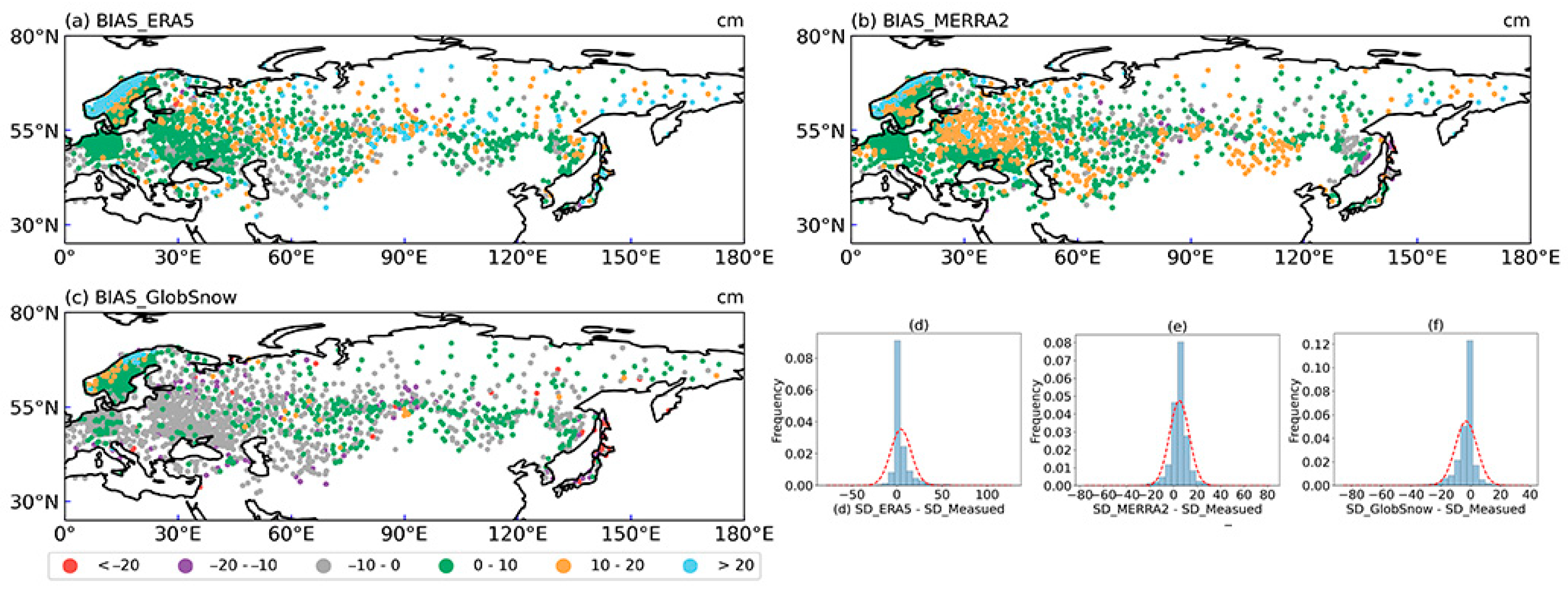
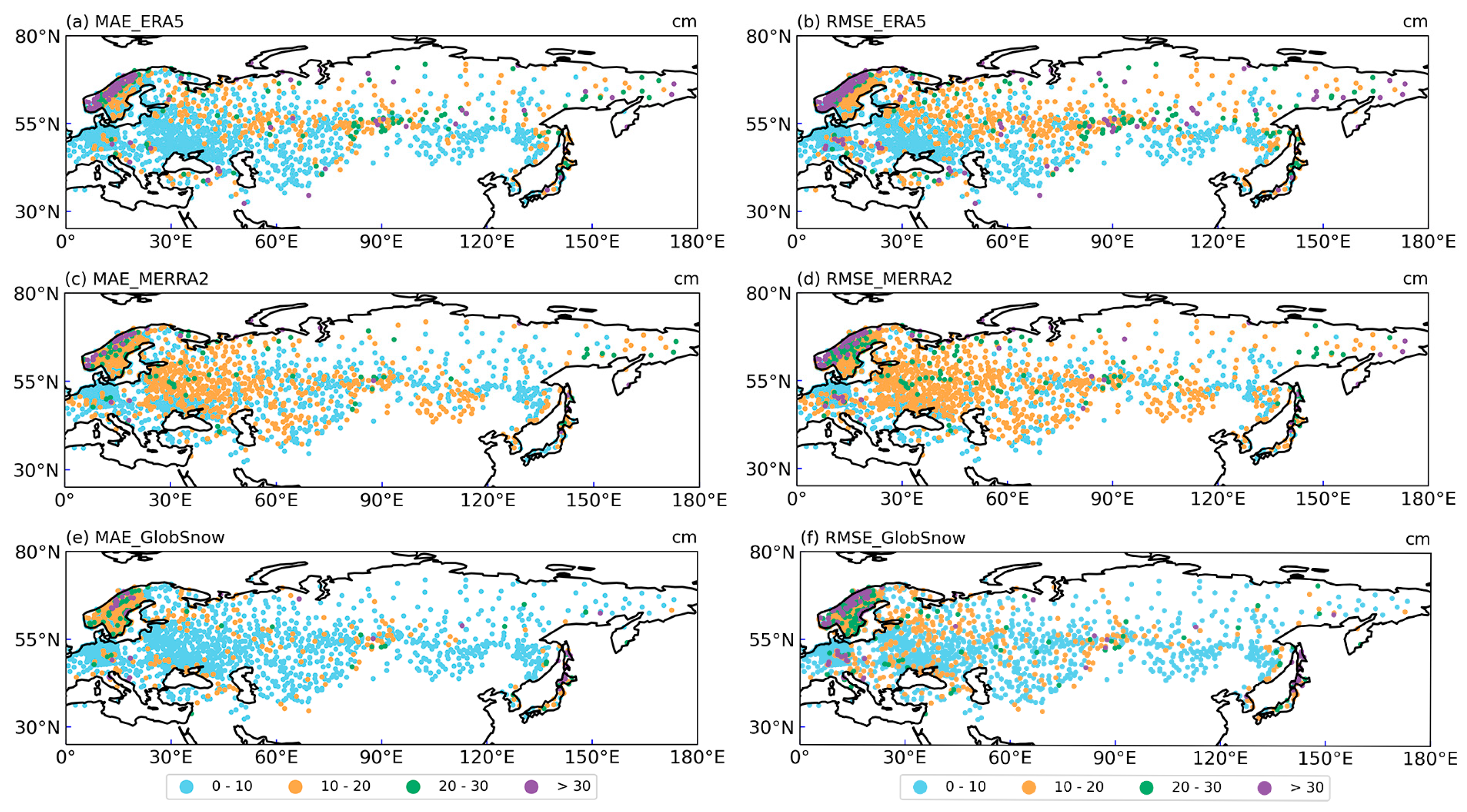
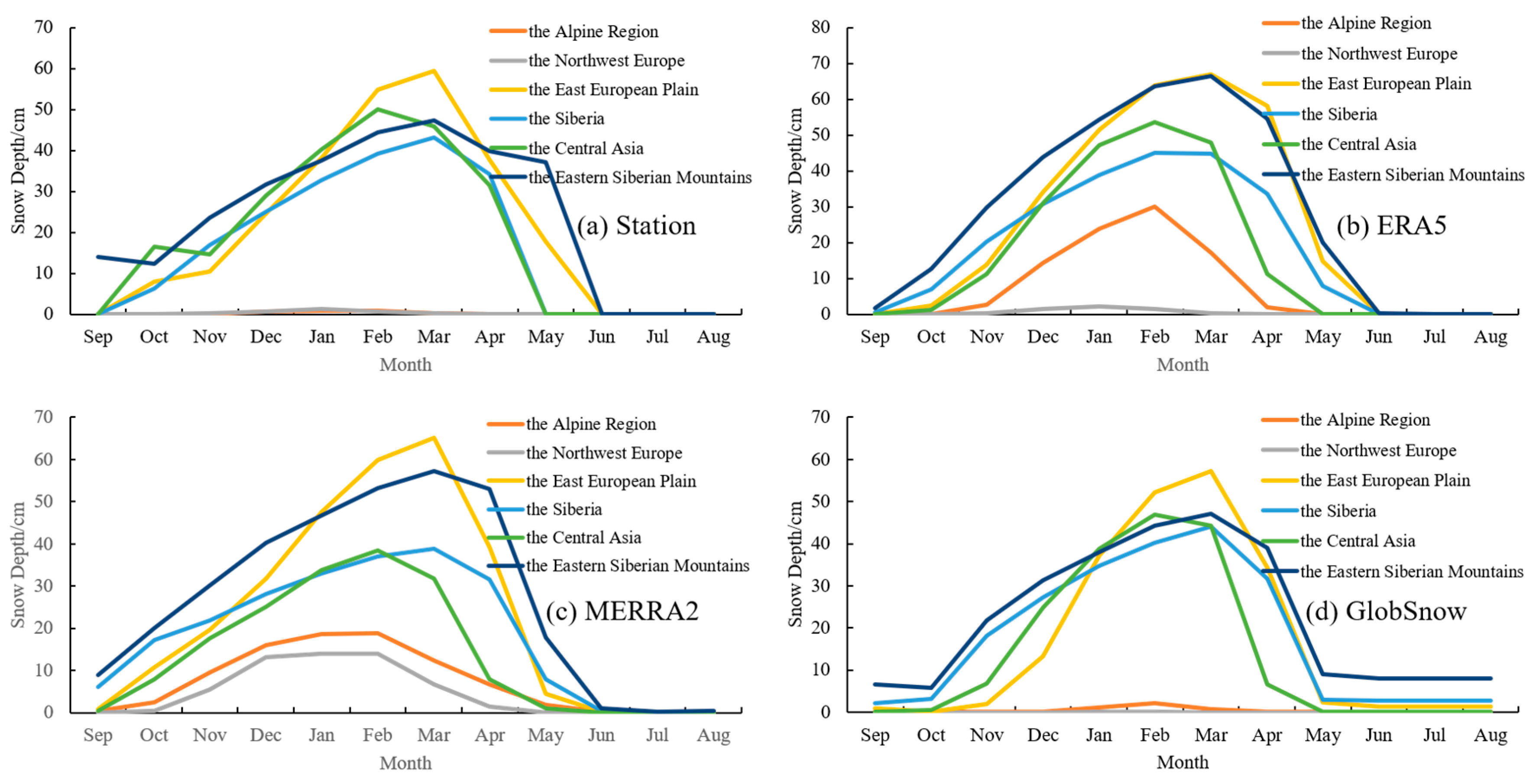
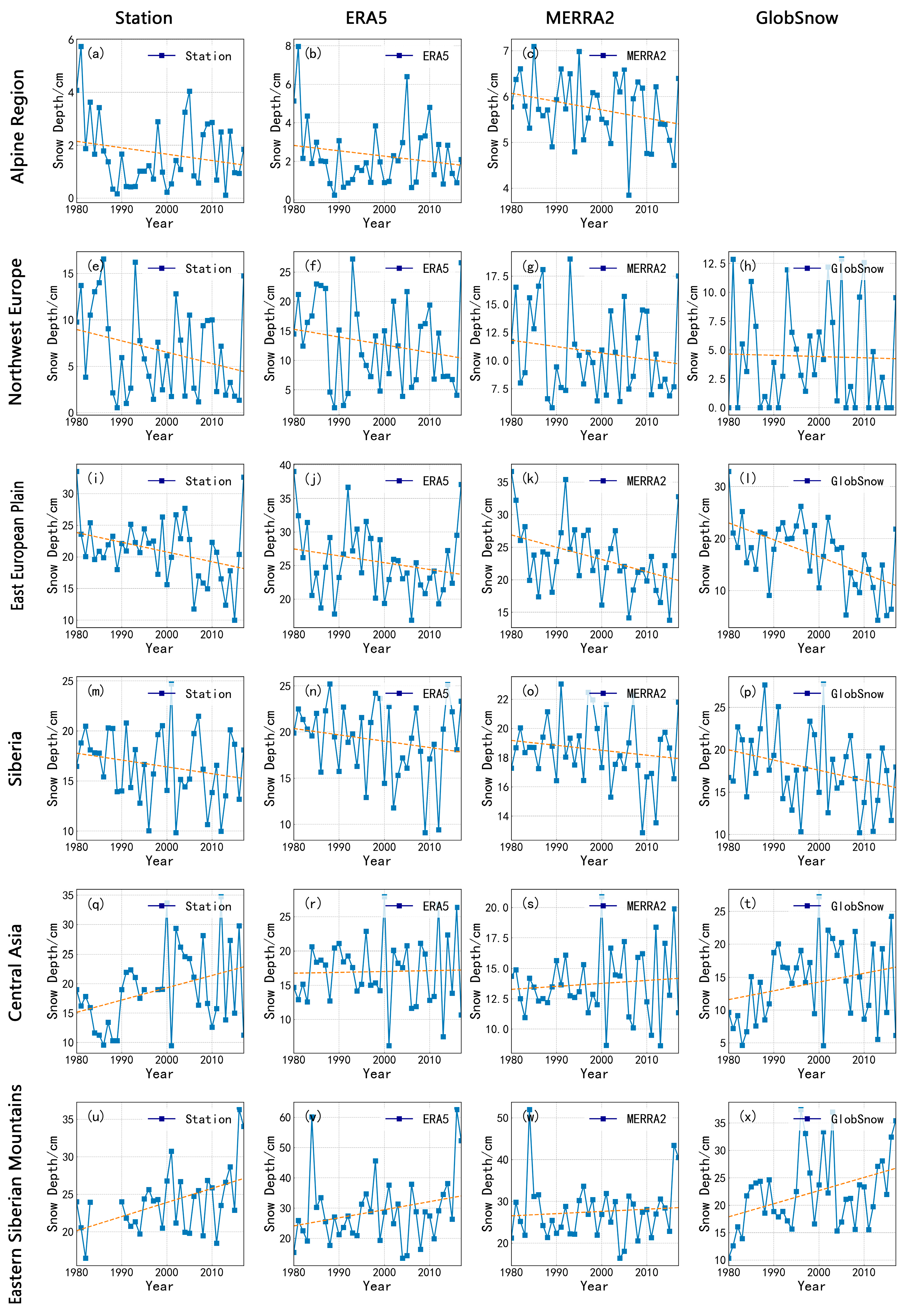


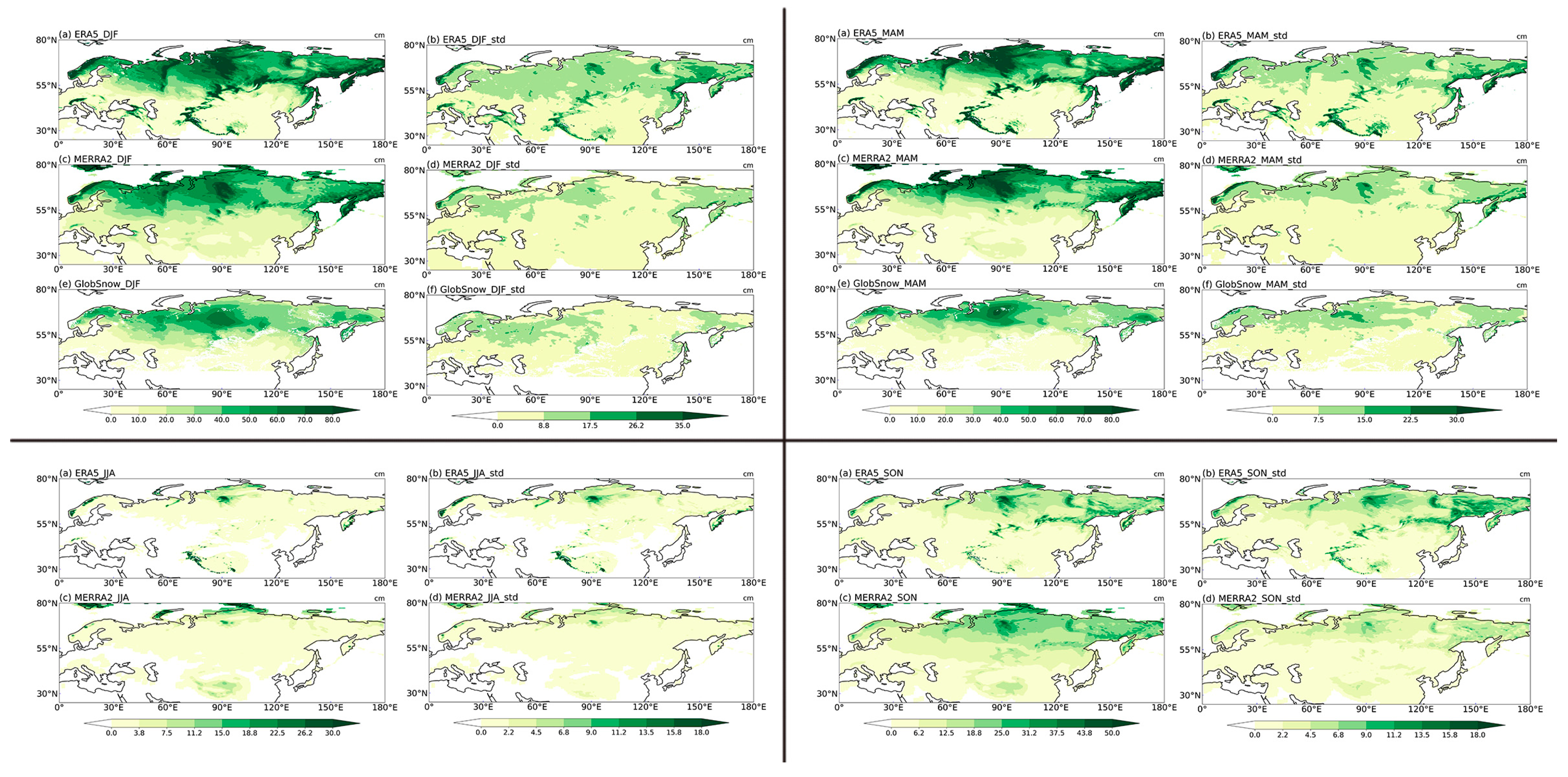
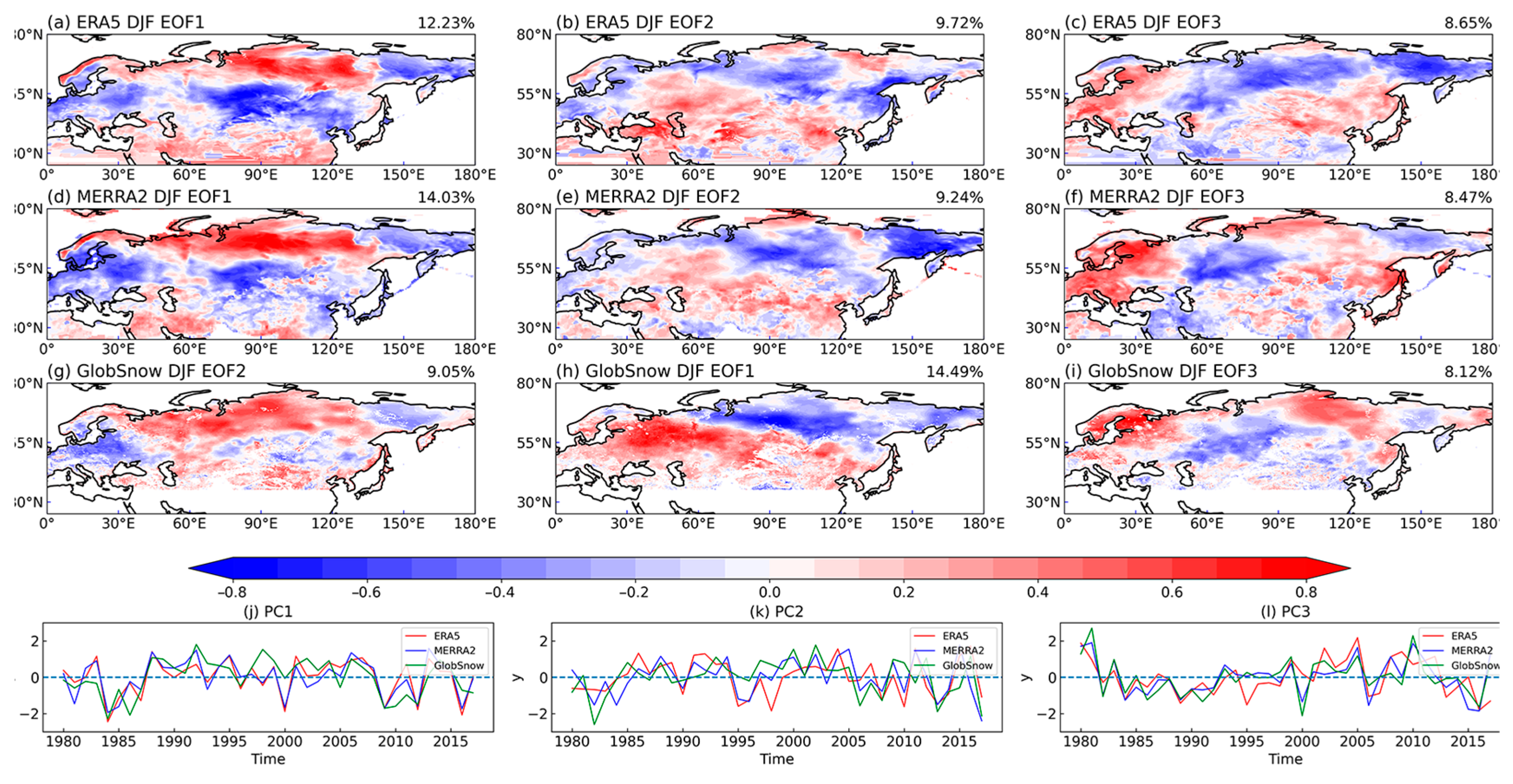

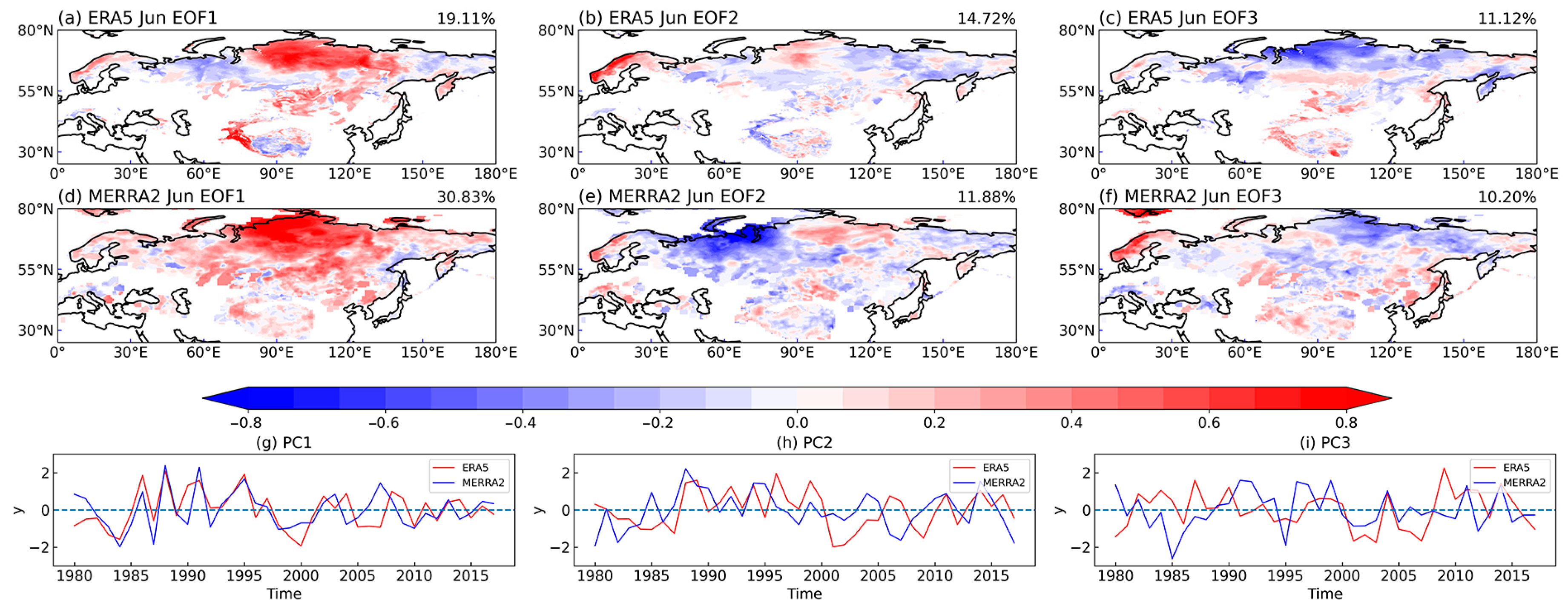
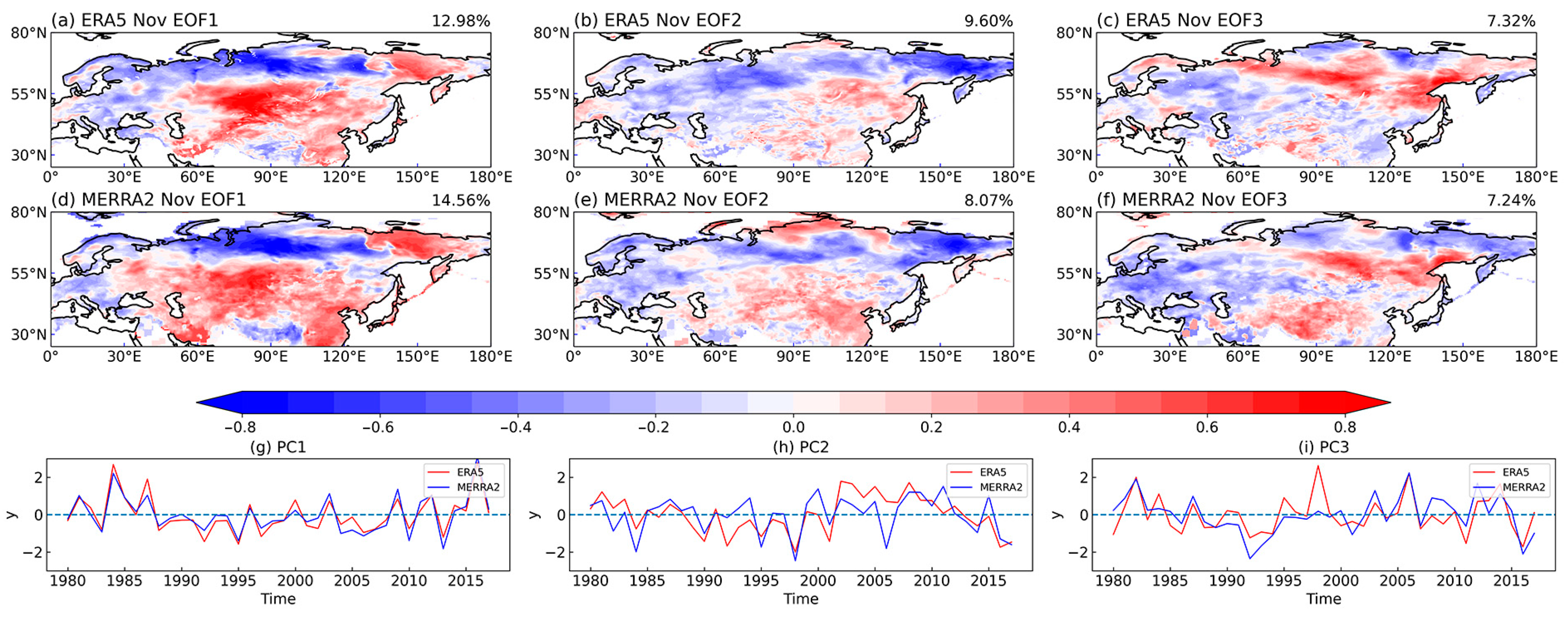
| MAE | RMSE | |||||
|---|---|---|---|---|---|---|
| ERA5 | MERRA2 | GlobSnow | ERA5 | MERRA2 | GlobSnow | |
| Alpine region | 3.85 | 6.77 | 4.67 | 6.69 | 9.45 | 7.12 |
| Northwest Europe | 5.93 | 7.25 | 5.37 | 8.93 | 10.51 | 8.81 |
| East European Plain | 7.03 | 11.91 | 6.24 | 9.08 | 13.71 | 8.71 |
| Siberia | 14.13 | 10.79 | 7.25 | 16.75 | 12.83 | 9.63 |
| Central Asia | 8.19 | 10.03 | 6.5 | 10.1 | 11.45 | 8.08 |
| Eastern Siberian Mountains | 17.17 | 13.34 | 6.96 | 20.52 | 15.56 | 9.14 |
Disclaimer/Publisher’s Note: The statements, opinions and data contained in all publications are solely those of the individual author(s) and contributor(s) and not of MDPI and/or the editor(s). MDPI and/or the editor(s) disclaim responsibility for any injury to people or property resulting from any ideas, methods, instructions or products referred to in the content. |
© 2024 by the authors. Licensee MDPI, Basel, Switzerland. This article is an open access article distributed under the terms and conditions of the Creative Commons Attribution (CC BY) license (https://creativecommons.org/licenses/by/4.0/).
Share and Cite
Cheng, K.; Wei, Z.; Li, X.; Ma, L. Multi-Source Dataset Assessment and Variation Characteristics of Snow Depth in Eurasia from 1980 to 2018. Atmosphere 2024, 15, 530. https://doi.org/10.3390/atmos15050530
Cheng K, Wei Z, Li X, Ma L. Multi-Source Dataset Assessment and Variation Characteristics of Snow Depth in Eurasia from 1980 to 2018. Atmosphere. 2024; 15(5):530. https://doi.org/10.3390/atmos15050530
Chicago/Turabian StyleCheng, Kaili, Zhigang Wei, Xianru Li, and Li Ma. 2024. "Multi-Source Dataset Assessment and Variation Characteristics of Snow Depth in Eurasia from 1980 to 2018" Atmosphere 15, no. 5: 530. https://doi.org/10.3390/atmos15050530
APA StyleCheng, K., Wei, Z., Li, X., & Ma, L. (2024). Multi-Source Dataset Assessment and Variation Characteristics of Snow Depth in Eurasia from 1980 to 2018. Atmosphere, 15(5), 530. https://doi.org/10.3390/atmos15050530






